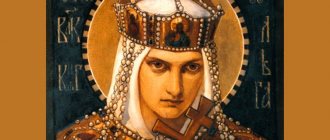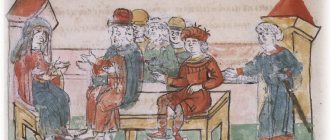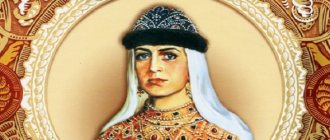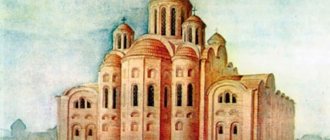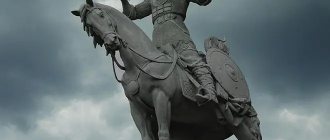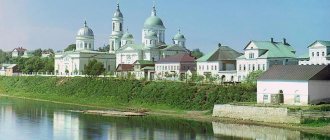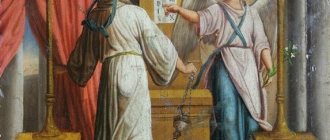Portraits from historical chronicles
Grand Duchess Olga Hood.William Tooke
Archontissa Olga pic. from an old book
Duchess Olga. Illustration from the book “Domestic Pantheon. Grand Dukes, Tsars and Emperors." Moscow. 1846
Meeting my husband and marriage
The meeting of Igor and Olga is also full of mysteries. According to the most common legend, they met at a river crossing near Pskov, where Igor was hunting. While crossing by boat, the prince noticed that the boatman was a young girl dressed in men's clothing. Igor immediately began to pester her, but the girl gave a sharp rebuff, promising to push the impudent man into the river.
When the time came later for Igor to choose a wife, he sent for the girl, not wanting another wife. At that time, Olga was 12 years old.
The date of the wedding - 903 - raises a number of questions among historians, since the first child was born to the couple only in 942, that is, almost 40 years later. Most likely, the year was set at random by the monk Nestor when he was trying to put events in chronological order.
Later, Olga will be briefly mentioned only in 942 in connection with the birth of Svyatoslav Igorevich and after the death of her husband.
Images from the Radziwill Chronicle, late 15th century
Olga's reception of the Drevlyan ambassadors, who offered her, after the murder of Igor, to become the wife of the Drevlyan prince Mal.
The departure of the Drevlyan ambassadors after a conversation with Olga; Olga's order to punish the ambassadors
Olga’s first revenge for the murder of Igor: the burial of the Drevlyan ambassadors sitting in the boat alive in a deep hole.
Olga’s second revenge for the murder of Igor: the burning of the newly arrived Drevlyan ambassadors in the bathhouse.
Olga's cry over Igor's coffin; the creation, at her command, of a large mound over Igor’s grave.
Olga's third revenge for the murder of Igor: plentiful treatment of the Drevlyan warriors with wine and reprisal against them.
The battle of the troops of Olga and Svyatoslav Igorevich with the army of the Drevlyans; defeat of the Drevlyans and their flight to their cities.
Collection of birds by the Drevlyans; offering tribute to Olga, three doves and three sparrows from the yard.
Olga's fourth revenge for the murder of Igor: burning of the Drevlyan city of Iskorostsnya with the help of birds, reprisal against its population.
The reign of Olga with Svyatoslav Igorevich in Kyiv.
Olga’s establishment of graveyards and imposition of tribute on the population throughout the land; reign of Olga and Svyatoslav Igorevich in Kyiv.
Olga’s refusal of the offer of the Byzantine Emperor Constantine Porphyrogenitus to become his wife; offering Olga royal gifts.
Blessing of Olga by the Byzantine Patriarch; Olga's sailing from Constantinople to Kyiv
Olga's reception of the ambassadors of the Byzantine Emperor Constantine Porphyrogenitus; the departure of ambassadors from Kyiv after Olga’s refusal of the emperor’s request for reciprocal gifts.
Olga's persuasion of her son Svyatoslav Igorevich to accept Christianity; Olga's prayers for the well-being of her son and her subjects.
The flight of the Pechenegs, frightened by the possibility of the arrival of Svyatoslav Igorevich with his squad; Olga's meeting with her grandchildren and close people on the banks of the Dnieper of the squad in boats that arrived to help.
Olga's message to Svyatoslav Igorevich about the Pecheneg invasion of Russian lands; Svyatoslav's return to Kyiv and his meeting with Olga, children and the population.
Death, mourning and burial of Olga.
1.Domestic policy
| Activities | results |
| Improving the taxation system. | She carried out tax reform, introduced lessons - the amount of tribute, which was clearly defined. |
| Improving the system of administrative division of Rus'. | She carried out an administrative reform: she introduced administrative units - camps and graveyards, where tribute was brought. |
| Further subjugation of the tribes to the power of Kyiv. | She brutally suppressed the uprising of the Drevlyans, set fire to Iskorosten (she avenged the death of her husband according to custom). It was under her that the Drevlyans were finally subjugated. |
| Strengthening Rus', active construction. | During Olga’s reign, the first stone buildings began to be built, stone construction began. She continued to strengthen the capital, Kiev. During her reign, cities were actively improved, and the city of Pskov was founded. |
Subject paintings
I. A. Akimov
The baptism of Princess Olga in Constantinople. I. A. Akimov
I. Mashkov
Olga enters the Church of St. Sophia, Constantinople. I. Mashkov
O. Markelov
Princess Olga and Svyatoslav Khud. O. Markelov
Olga in Tsaregrad Hood. O. Markelov
Olga in Tsaregrad Hood. O. Markelov
V. K. Sazonov
The first meeting of Prince Igor with Olga. Artist V. K. Sazonov
V. I. Surikov
“Princess Olga meets the body of Prince Igor, killed by the Drevlyans” Thin sketch. V. I. Surikova
I. E. Ozhiganov
Olga with her son - Waiting for thin. I. E. Ozhiganov
S. A. Kirrilov
Princess Olga (Epiphany) Art. S. A. Kirrilov
P.V. Ilyin
Princess Olga Khud. P.V. Ilyin
B. A. Chorikov
“Olga takes revenge on the Drevlyans” Hood. Chorikov B. A.
“Olga Receives Baptism” Hood. Chorikov B. A.
I. A. Akimov
Grand Duke Svyatoslav kissing his mother and children upon returning from the Danube to Kyiv. Hood, I. A. Akimov, 1773
V. M. Vasnetsov
Princess Olga Khud. V. M. Vasnetsov
M. V. Nesterov
Princess Olga Khud. M. V. Nesterov
Unknown thin
Princess Olga Unknown. thin
V. Shvachko
Princess Olga Khud. Vladimir Shvachko
A. O. Orlenov
Princess Olga accompanies Svyatoslav on his campaign, 964. Hood. A. O. Orlenov
F. A. Bruni
Olga's revenge on the Drevlyans Engraving by F. A. Bruni, 1839
Princess Olga at the walls of ancient Iskorosten” (artist A.A. Turansky, 1982)
S. Efroshkin
S. Efoshkin. Ancient Rus'. Duchess Olga. In prayer
S. Efoshkin. Princess Olga. Blessing
S. Efoshkin. Duchess Olga. Baptism
S. Efoshkin. Ancient Rus'. Prince Igor and the future Princess Olga
Olga burns the main city of the Drevlyans, Khud. S. Efoshkin.
Funeral of Princess Olga. S. Efoshkin.
Mysteries of origin
It is almost impossible to determine the exact date of birth of Princess Olga due to the lack of written sources. Most are inclined to believe that the ruler was born at the end of the 9th - beginning of the 10th century, or more precisely, in 890−894 or 927−928. Difficulties in establishing the exact date are associated with a large number of inaccuracies and confusion in the surviving written sources.
Nothing is known about the parents. It is assumed that she was of humble origin, probably of Varangian (Scandinavian) origin. This is confirmed by the name of the girl herself (“Olga” comes from the Scandinavian “Helga”) and by finding traces of the presence of Scandinavians in that place and at that time.
There are several options for Olga’s origin:
- The Tale of Bygone Years says that the future Grand Duchess was born 12 km from Pskov in the village of Vybuty. Nothing is said about her parents.
- At the end of the 15th century, the Typographical Chronicle and the Piskarevsky chronicler put forward the opinion that Olga was the daughter of the Prophetic Oleg, who ruled Russia during the childhood of Igor Rurikovich. He also organized the wedding of the prince and his daughter.
- The Joachim Chronicle (dubious from the point of view of reliability) believes that Olga was of noble Slavic origin. The name itself is a female version of the name “Oleg”.
- At the end of the 19th century, a theory appeared about the Bulgarian origin of the princess, based on the “New Vladimir Chronicler” - a later copy (copy) of the “Tale of Bygone Years”. It talks about Olga’s Bulgarian origin - from the then capital of Pliska. In the Old Slavic language, the cities “Pskov” and “Pleskov” were written the same way, which could have caused a copyist error.
Unfortunately, it is not yet possible to establish the truth, but the first option is considered the most likely.
Baptism and death
The circumstances of the baptism of the first ruler of Rus' have not been fully clarified by history. Main versions:
- The Tale of Bygone Years says that it was in 955. The baptism was performed by Patriarch Theophylact of Constantinople and Emperor Constantine VII. Olga received the name Elena. There is also a legend about Olga’s supposedly cunning trick: Konstantin, captivated by the princess’s beauty, wanted to take her as his wife, but she refused due to the difference in religions. Then the emperor baptized her, but the wedding again became impossible, since from now on Konstantin was Olga’s godfather.
- Most other sources name 957 as the date of Olga's baptism. The godparents were Patriarch Polievkt and the son of Constantine VII Roman II. Nothing is said about why the princess decided to change her faith.
Olga's life was cut short in 969. She was buried according to Christian custom. Most likely, already during the reign of Yaropolk Svyatoslavovich, the eldest grandson of the princess, she was revered as a saint: her relics were transferred to the church, and some miracles occurred. Under Vladimir the Wise, nicknamed the Baptist, Yaropolk's heir and youngest grandson, the saint's relics were transferred to the Kyiv Church of the Holy Mother of God.
Official canonization occurred only in the middle of the 13th century ; in the middle of the 16th century, Olga was canonized as a saint equal to the apostles.
The biography of Princess Olga is interesting and unusual in that she is the first woman to sit on the Russian throne. She is best known for her brutal revenge on her husband’s murderers and her adoption of Christianity - in fact, she was the first baptized ruler in Rus'. She is also known as a renowned saint, the patroness of widows and new believers.
